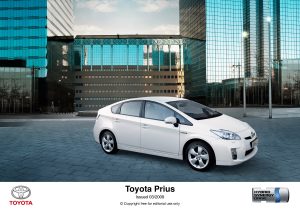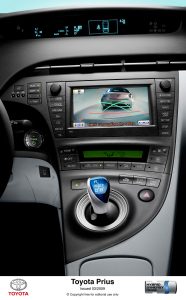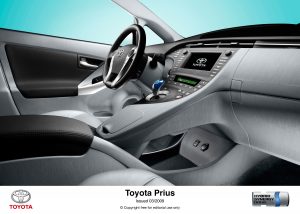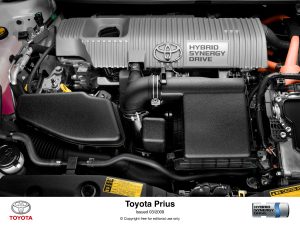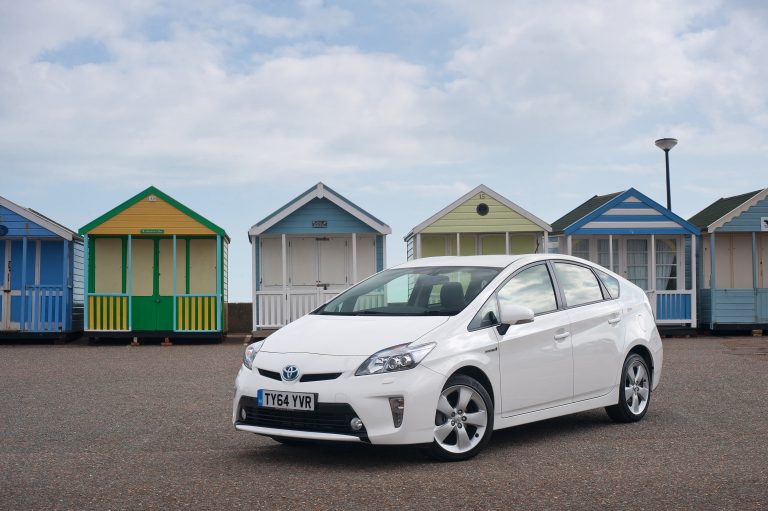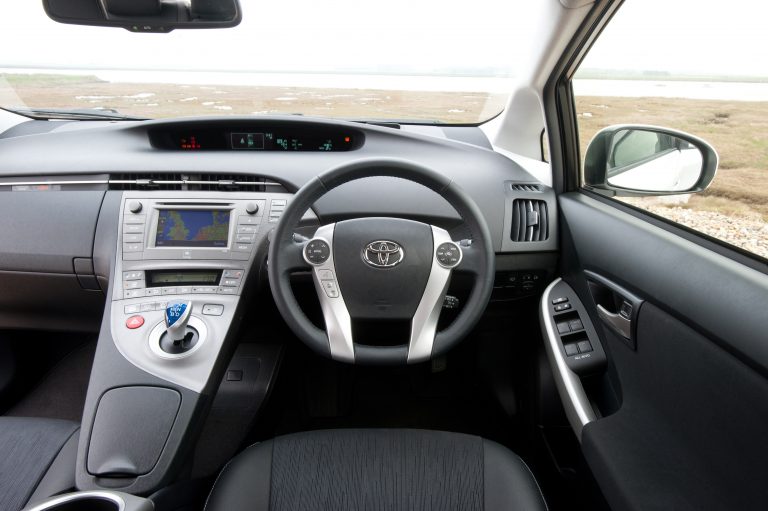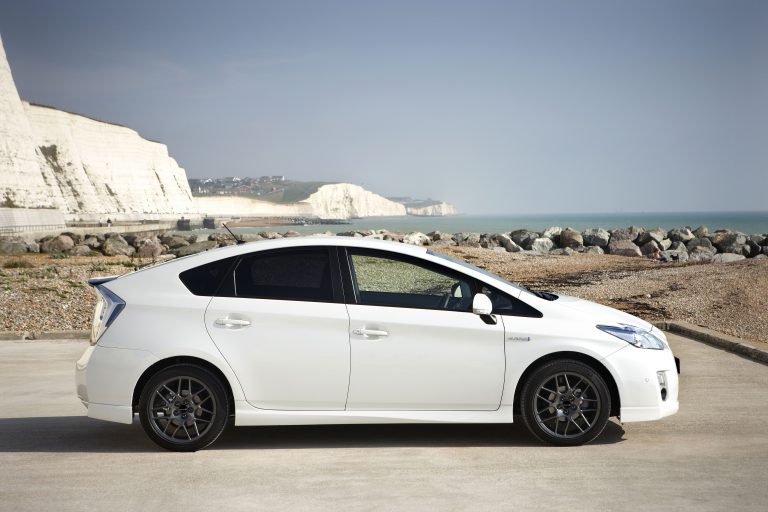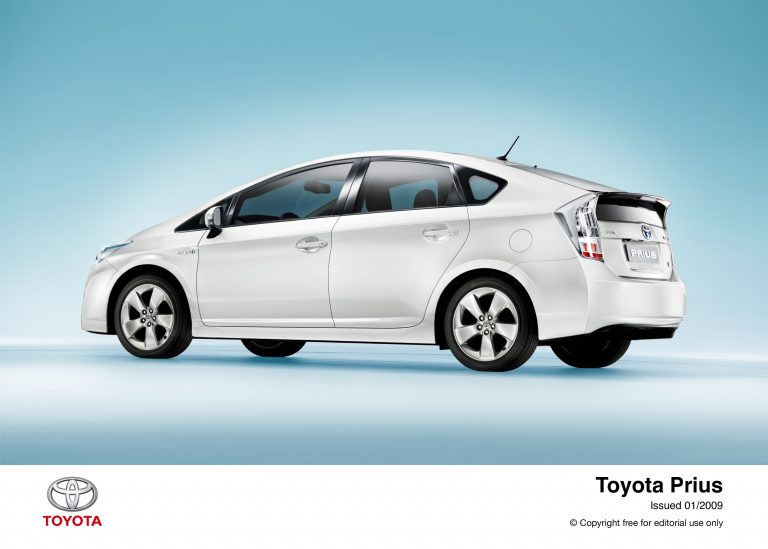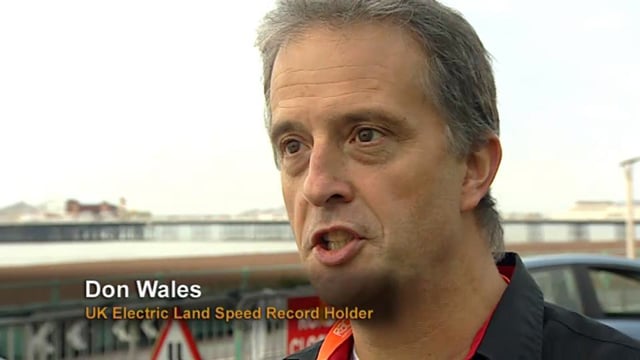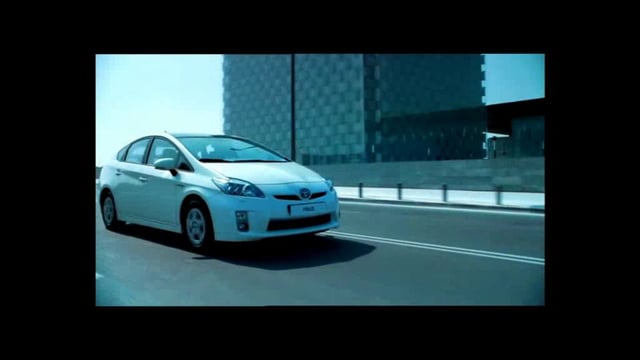European Debut for New Toyota Prius
Introducing the world’s most advanced mainstream car
KEY POINTS
- Next-generation of Hybrid Synergy Drive, the undisputed reference point for hybrid technology
- Power increased by 22 per cent to 134bhp, fuel economy by 10 per cent (72.4mpg official combined cycle) and CO2 emissions down 14 per cent at just 89g/km
- Three on-demand drive modes – EV, ECO and POWER
- Exceptionally low drag coefficient, Cd 0.25
- Ergonomic, dual-zone cockpit design with ‘display’ and ‘command’ zones
- Hi-tech innovations, including solar ventilation system and head-up and Touch Tracer displays
- World’s first injection moulded ecological plastic, derived from plants, reducing product cycle CO2 levels
“The new-generation Prius is the most advanced mainstream car on the market. Prius builds on more than 10 years of history and will remain the undisputed reference point for hybrid technology. Beyond confirming its environmental leadership, the new-generation Prius sets new standards in terms of status, innovation, design and driving pleasure. New Prius will further enhance the appeal of the Toyota brand by creating affinity with an even broader audience.”
Andrea Formica, Senior Vice President, Toyota Motor Europe
The first-generation Prius was the world’s first mass-produced hybrid vehicle. Launched in Japan in 1997 and in Europe in 2000, the unique Toyota hybrid established a major industry milestone in vehicle powertrain development and sustainable mobility. The name Prius, ‘to go before’ in Latin, became symbolic of a car that was launched even before environmental awareness had become a mainstream social issue.
Anticipating the 21st century’s need for vehicles with exceptional fuel efficiency, successive generations of Prius have showcased Toyota’s commitment to environmentally conscientious forward thinking, and led the company’s drive towards the creation of the ultimate eco-car.
Toyota’s full hybrid, series/parallel Hybrid Synergy Drive system has been fundamental to the global success of Prius, representing as it does an unmatched synergy of high technology and ecological responsibility in powertrain design. The car itself was voted European Car of the Year 2005 and its Hybrid Synergy Drive powertrain was named 2004 International Engine of the Year, going on to win the Green Engine of the Year title for the last five years in a row.
Today new Prius remains the undisputed reference point for mainstream vehicle hybrid technology, setting new standards in innovation, design and driving enjoyment. Its next-generation Hybrid Synergy Drive system features comprehensive improvements to the award-winning powertrain. Ninety per cent of the hybrid drive components have been redesigned to create a lighter, more compact system, with a focus on increased power, further reductions in real-world fuel consumption and improved cold weather operation.
System power has been increased by 22 per cent to 134bhp, fuel economy improved by 10 per cent to 72.4mg and CO2 emissions reduced by 14 per cent to just 89g/km.
The third-generation Prius should not be seen as a niche model to be evaluated only against specialised criteria. Despite delivering CO2 emission levels below A and B-segment cars, its on-road performance and dynamic abilities bear comparison with any D-segment competitor. Continued customer approval is witnessed in Prius’s top ranking in J.D. Power and Associates’ UK, French and German customer satisfaction surveys over the last two years.
New Prius has a striking, ECO-ICON concept vehicle-inspired design with an exceptionally low drag coefficient, Cd 0.25. The ergonomically advanced interior features an innovative dual-zone dashboard design and a number of driver assistance technologies that are unique in the segment, including a head-up display, Touch Tracer display, solar ventilation and Intelligent Parking Assist.
Global sales figures continue to reflect Prius’s popular status as the world’s most technologically and environmentally advanced mainstream car. By the end of 2008 worldwide sales of the planet’s most popular hybrid vehicle exceeded 1.2 million, with European sales nearing 130,000 units.
In spite of increased competition, Prius sales have accelerated in recent years, with more than 41,000 sold in Europe in 2008 alone. With a target of 80,000 sales in 2010, Europe will make a significant contribution to Toyota’s aim of one million worldwide sales of Hybrid Synergy Drive vehicles by the early 2010s. New Prius will be sold in 80 countries, almost double the 44 markets where it is currently sold.
NEXT-GENERATION HYBRID SYNERGY DRIVE
- Full hybrid, series/parallel system architecture
- 90 per cent component redesign for lighter, more compact and efficient system
- Power increased by 22 per cent to 134bhp
- Fuel economy improved to 72.4mpg
- CO2 emissions down 14 per cent at 89g/km
- New 1.8-litre VVT-i Atkinson cycle petrol engine with cooled Exhaust Gas Recirculation
- EV, ECO and POWER on-demand driving modes
- Eco Drive Support Monitor for more fuel-efficient driving
New Prius’s next-generation Hybrid Synergy Drive system features comprehensive improvements with 90 per cent of the hybrid drive components redesigned to create a lighter, more compact system that delivers more power, uses less fuel in real-world conditions and which operates better in cold weather.
System power output has been increased by 22 per cent, from 109 to 134bhp (110 to 136 DIN hp) and, with performance to match a conventional 2.0-litre petrol vehicle, new Prius will accelerate from nought to 62mph in 10.4 seconds.
At the same time overall fuel economy has been improved by 10 per cent, new Prius returning 72.4mpg in combined cycle driving. The adoption of a larger, 1.8-litre engine reduces the rpm during high-speed driving to give a 10 per cent gain in long-haul cruising fuel efficiency.
Prius easily exceeds the Euro 5 emissions standards, producing 89g/km of CO2. And when operating in EV mode at speeds up to 30mph, Prius uses no fuel and produces zero emissions.
Hybrid Synergy Drive System Components
Unlike parallel or ‘mild’ hybrids, which use supplementary electric motor power purely to boost petrol engine performance, or ‘series’ hybrids, which rely on electric power alone to drive the wheels, new Prius is a full hybrid capable of operation in petrol and electric modes alone, as well as a combination of both.
Hybrid Synergy Drive delivers the energy-saving benefits of a series hybrid combined with the performance benefits of a parallel hybrid, endowing new Prius with impressive, seamless acceleration and remarkably quiet operation, yet also returning class-leading fuel efficiency and ultra-low emissions.
The system comprises a 1.8-litre VVT-i petrol engine, a powerful electric motor, a generator, a high-performance battery, a power control unit and a power split device, which uses a planetary gear set to combine and re-allocate power from the engine, electric motor and generator as required.
The key to the successful installation of Hybrid Synergy Drive within Prius’s front-engine platform is the housing of the electric motor, generator and power split device on a single, lightweight and highly compact transmission casing that is directly comparable in size to a conventional gearbox. The new transaxle itself is smaller, 20kg lighter and benefits from a 10 to 20 per cent reduction in driveshaft energy losses.
1.8-litre VVT-i Atkinson Cycle Engine
A new four-cylinder, 1.8-litre VVT-i Atkinson cycle petrol engine replaces the 1.5-litre unit in current Prius. Generating 97bhp (98 DIN hp) at 5,200rpm and 142Nm of torque at 4,000rpm, it delivers higher torque at lower revs – a reduction of 300rpm at 75mph – and combines quieter running with a 10 per cent improvement in long distance cruising fuel economy.
Adopting the Atkinson cycle and a new, cooled exhaust gas recirculation system brings significant gains in fuel efficiency and emissions reduction.
Because the intake valves close late in an Atkinson cycle engine, compression is delayed. This creates a high expansion ratio for less compression, reducing intake and exhaust energy losses and converting combustion energy to engine power more effectively. As a result the exhaust temperature is lower than that of conventional engines. Cooled Exhaust Gas Recirculation reintroduces the cooled gas into the intake system, further reducing engine operating temperatures.
Together, these technologies minimise situations when the cooling effect of fuel enrichment is necessary to prevent overheating damage to the catalytic converter, thus improving fuel economy and emissions.
Prius has a new engine heat management system that improves fuel economy in cold weather and cabin comfort, using a heat recovery system and an electric water pump. Using an electric system in place of the water pump drive belt reduces mechanical losses and, as a result, the coolant flow rate can be controlled with greater precision, achieving better fuel efficiency.
80bhp Electric Motor
New Prius has an 80bhp (60kW) electric motor that works in tandem with the petrol engine to improve acceleration, and which powers the driven wheels alone when the vehicle is operating in EV mode. Compared to the motor used in the current Prius, the motor is 20 per cent more powerful, yet 33 per cent smaller.
During deceleration and under braking, the electric motor acts as a high-output generator to effect regenerative braking, optimising energy management in the Hybrid Synergy Drive system by recovering kinetic energy that would normally be lost as heat as electrical energy for storage in the high-performance battery.
Power Control Unit
The Power Control Unit (PCU) consists of a voltage boost converter, an inverter and a DC/DC converter, controlled by a motor control ECU that receives commands from the hybrid vehicle control ECU.
The new inverter, 36 per cent lighter and 37 per cent more compact than before, has faster switching for improved efficiency and now converts the battery’s direct current into a higher, 650V (+150V) alternating current to drive the electric motor and, on occasion, the generator, giving significantly improved PCU performance.
High Output Battery
Output from the nickel-metalhydride Hybrid Synergy Drive battery, a proven reliable battery technology, has been increased to a maximum 27kW (+2kW), allowing new Prius to be driven in EV mode, using electric motor power alone.
The battery has been reduced in size to minimise impact on cabin space. The efficiency of its cooling system has been improved with a significant increase in fan capacity.
Three On-demand Driving Modes
New Prius’s seamless, e-AT intelligent electronic transmission is supplemented by a choice of three ‘on-demand’ driving modes that can be selected to increase driving efficiency, performance and fuel economy.
From start-up and at speeds of less than 31mph (50km/h), new Prius automatically operates in EV mode, using its electric motor power alone. The driver can also select EV mode manually, with driving range dictated by the level of battery charge. In urban motoring Prius can operate with minimal noise and zero emissions and as the petrol engine is switched off in EV mode, it contributes to a significant reduction in overall fuel consumption.
In ECO mode, throttle response to aggressive accelerator pedal inputs is reduced and the air conditioning control is adjusted for improved fuel economy. Depending on driving conditions, ECO mode can help drivers achieve a 10 to 15 per cent reduction in fuel consumption.
Finally POWER mode modifies response to throttle inputs, boosting power to improve acceleration and give greater driving pleasure.
Eco Drive Monitor
Drivers are helped to make the most of Prius’s efficiency with the Eco Drive Monitor, which displays information relating to the operation of the Hybrid Synergy Drive system.
The Energy Monitor shows the engine’s current operating conditions and the electric power flow. Working in real time, it helps the driver understand the basic energy flow through the system.
The Hybrid System Indicator displays real-time accelerator use, helping the driver modify throttle inputs and driving style to gain maximum fuel efficiency.
A 1min/5min Consumption monitor presents trip computer mileage and average fuel consumption for the past one-minute and five-minute driving intervals.
The Past Record monitor displays previous trip computer mileage and average fuel consumption records.
Improved Driving Dynamics
New Prius is built on an all new platform that features extensive revisions to the geometry of the front MacPherson strut and rear torsion beam suspension systems.
Improvements to the front suspension include increased roll stiffness and caster angle to give a more natural steering feel. Together these revisions have significantly enhanced the car’s handling agility, stability and ride comfort.
EXTERIOR DESIGN
- Faithful interpretation of the ECO-ICON design concept
- Exceptionally low drag coefficient, Cd 0.25
- Improved front and rear visibility
- Higher roofline gives better rear passenger headroom
The third-generation Prius draws heavily on the styling cues of Toyota’s ECO-ICON design concept with a distinctive exterior that focuses on maximising aerodynamic efficiency. In this way the design supports the lightweight construction and Hybrid Synergy Drive powertrain in maximising fuel efficiency.
Prius’s characteristic, sweeping monobox profile is maintained, with attention paid to minimising panel gaps, giving the door and glazing seals a smooth profile and sculpting aerodynamically efficient door mirrors. Even the lamp clusters and front air intakes have been painstakingly detailed to optimise air flow and minimise wind turbulence.
The result is an exceptionally aerodynamic vehicle, with the coefficient of drag improving from Cd 0.26 (for the second generation Prius) to Cd 0.25.
Significant improvements have been made to the car’s proportions and packaging. The overall length has grown by 15mm to 4,460mm, all of which is accounted for by an increase in the front overhang; the wheelbase is unchanged at 2,700mm (same as new Toyota Avensis). Width is greater by 20mm at 1,745mm, helping give the car better stability and a more dynamic stance. To maintain aerodynamic efficiency, the overall height remains 1,490mm, but the highest point of the roof has been moved further back to help improve rear seat headroom by 12mm.
Extra dynamism has been added to the design by moving the A-pillar forward, increasing the rake of the windscreen, which in turn increases the size of the front quarterlights, improving visibility. The extended rear roofline allows for a better rearward view from the driver’s seat.
Hybrid blue Toyota badging denotes the presence of Hybrid Synergy Drive and new exterior colours will be available, specific to hybrid models.
Bespoke 15 or 17-inch alloy wheels are available, both fitted with low rolling resistance tyres.
INTERIOR DESIGN
- Ergonomic cockpit with ‘display’ and ‘command’ zones
- New, more comfortable front seats
- Extensive storage and extra boot space
The dominant feature of new Prius’s interior is a dual-zone dashboard designed to minimise the time the driver has to look away from the road ahead to view information and provide superb functionality for all controls and switchgear.
The upper ‘display’ zone comprises a new head-up display and a central meter cluster positioned at an ideal distance for at-a-glance reading. As well as conventional information such as vehicle speed, the LED meter incorporates the Eco Drive Monitor and its four vehicle and powertrain status displays (see above).
The ‘command’ zone features a distinctive central ‘bridge’ element that positions the gearshift close to the driver’s hand and also creates a generous lower storage compartment. The focus of this part of the cockpit is a full-colour multi-information display screen, with controls for the air conditioning, audio system and satellite navigation all within easy reach for the driver.
A new front seat design improves comfort and adjustability. The range of adjustment has been increased in every direction: base sliding distance increases by 20mm to 260mm and, using a side lever for easier operation, height adjustment is greater by 15mm at 60mm. Although the seats have better lumbar support, the seat back structure has been reduced in thickness by 35mm, giving more knee room for rear seat passengers. Active front headrests improve protection against whiplash injuries.
The rear seats gain integrated headrests, giving the driver better rearward vision. There is also more legroom and 15mm more headroom.
Larger and additional storage has been provided, including 3.0-litre upper and 6.0-litre lower gloveboxes, a console tray beneath the dashboard ‘bridge’ and a 3.7-litre centre armrest box, which contains a 12V power outlet and an audio mini-jack input socket.
The luggage compartment has an additional 30 litres of space, up to 445 litres, thanks to the more compact and repackaged Hybrid Synergy Drive battery.
HI-TECH INNOVATIONS
- Solar ventilation system
- Head-up display
- Touch Tracer display
- Extensive use of LED technology
- Pre-Crash Safety system with Adaptive Cruise Control
- Intelligent Parking Assist with Advanced Parking Guide
- World’s first ecological, plant-derived plastic, reducing product cycle CO2 levels
Third-generation Prius introduces numerous hi-tech innovations and active safety features to the D-segment.
Solar Ventilation
A solar ventilation system prevents the cabin air temperature from rising while the vehicle is parked. Solar panels integrated into the rear section of an optional sliding glass sunroof power an electric air circulation fan, with no need for the engine to be running. The first system of its kind to run on battery power alone, it reduces the cool-down time when the driver returns to the car, so minimising air conditioning use during start-up.
In a world first, as part of the system, the air conditioning itself can be operated remotely using the key fob, letting the driver cool the car down up to three minutes before starting a journey.
Head-up Display
A new head-up display is fitted as standard on all Prius models. This projects key vehicle information on to the base of the windscreen so it can be read by the driver without taking his or her eyes off the road. Featured data includes vehicle speed, Eco Drive Monitor and, where fitted, Active Cruise Control status and Pre-Crash Safety system information. On models equipped with satellite navigation, turn-by-turn and distance-to-exit details are also presented on the head-up display. The display can be adjusted for height and brightness, or can be switched off altogether.
Touch Tracer Control
A new Touch Tracer switch mounted on the steering wheel lets the driver control a number of on-board systems without taking his or her hands off the wheel. On touching the top of the switch, a control function layout is illuminated in the central meter cluster. The switch can then be used to select and control the audio, air conditioning and Eco Drive Monitor.
LED Technology
Light Emitting Diode (LED) technology is now used for Prius’s low beam headlamps, as well as the tail and stop lights. This can reduce vehicle electricity consumption by up to 30 per cent. LEDs also have a much longer life than conventional halogen or High Intensity Discharge (HID) lamps.
Pre-Crash Safety System
Prius’s Pre-Crash Safety system (PCS) sets a new benchmark for anticipatory, preventive safety in the D-segment. It uses a millimetre wave radar sensor to scan the road ahead, recognising potentially dangerous objects and helping the driver reduce the chances of a collision.
If a high collision risk is calculated, PCS will alert the driver to the hazard and, when he or she starts to apply the brake, provide braking assistance and simultaneously activate the seatbelt pretensioners.
Adaptive Cruise Control
Adaptive Cruise Control (ACC) works in tandem with the PCS system, using the same radar sensor to maintain a selected distance from the vehicle in front. Once the road ahead is clear, Prius automatically returns to its original cruising speed.
Intelligent Parking Assist
Intelligent Parking Assist (IPA) can help the driver negotiate parallel or series parking places. It uses a rear camera and ultrasonic sensors on the front wings to identify viable parking spaces and then input the appropriate steering angle. The system controls the steering to automatically guide the vehicle into the target parking position; no steering input is required from the driver, who simply controls vehicle speed during the manoeuvre. The system has been improved for new Prius, making it easier to use with significantly reduced operating times.
Plant-derived Eco-Plastic
Toyota has developed the world’s first injection moulded material derived from plant matter. Ecological Plastic is carbon-neutral and is used for the first time in new Prius. Toyota plans to extend its use in future vehicles.
There are two types of Ecological Plastic: those produced completely from plant-derived material, and those made from a combination of plant and petroleum-derived materials. As plants constitute a percentage of both types, Ecological Plastic contributes to lower CO2 emissions during the complete product lifecycle as most of the CO2 emitted at the time of disposal was originally captured from the atmosphere by photosynthesis while the plant was growing.
In new Prius this kind of plastic is used for foam and injection moulded parts in numerous locations, including the scuff plates, deck trim and seat cushions.
ENDS



